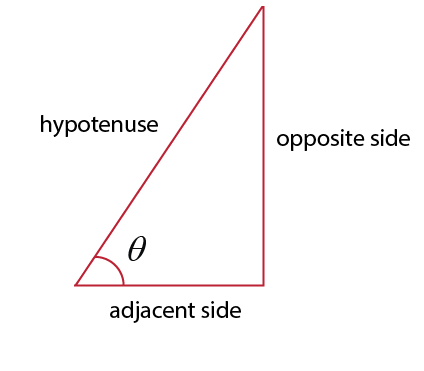
All Solutions
Section 5-1: Trigonometric Ratios of Acute Angles
$sin theta = dfrac{text{opposite side}}{text{hypotenuse}}$
$cos theta = dfrac{text{adjacent side}}{text{hypotenuse}}$
$tan theta = dfrac{text{opposite side}}{text{adjacent side}}$
$$
color{white} ddd
$$

opposite side = 5
adjacent side = 12
hypotenuse = 13
$sin theta = dfrac{5}{13}$
$cos theta = dfrac{12}{13}$
$tan theta = dfrac{5}{12}$
$csc theta =dfrac{1}{sin theta}=dfrac{13}{5}$
$sectheta=dfrac{1}{costheta}=dfrac{13}{12}$
$cot theta=dfrac{1}{tan theta}=dfrac{12}{5}$
{text{sin }}theta = frac{5}{{13}}{text{ ; csc }}theta = frac{{13}}{5} hfill \
cos theta = frac{{12}}{{13}}{text{ ; sec }}theta = frac{{13}}{{12}} hfill \
tan theta = frac{5}{{12}}{text{ ; cot }}theta = frac{{12}}{5} hfill \
end{gathered} ]
$csc theta=dfrac{1}{sintheta}$
$sectheta=dfrac{1}{costheta}$
$cottheta=dfrac{1}{tan theta}$
Therefore,
$sintheta=dfrac{8}{17}implies csctheta=dfrac{17}{8}$
$costheta=dfrac{15}{17}impliessectheta=dfrac{17}{15}$
$tantheta=dfrac{8}{15}implies cottheta= dfrac{15}{8}$
$sectheta=dfrac{17}{15}$
$cottheta=dfrac{15}{8}$
$csc theta=dfrac{1}{sintheta}$
$sectheta=dfrac{1}{costheta}$
$cottheta=dfrac{1}{tan theta}$
a) $sin theta=dfrac{1}{2}implies csctheta=dfrac{1}{frac{1}{2}}=2$
b) $costheta=dfrac{3}{4}implies sectheta=dfrac{1}{frac{3}{4}}=dfrac{4}{3}$
c) $tantheta=dfrac{3}{2}implies cottheta=dfrac{1}{frac{3}{2}}=dfrac{2}{3}$
d) $tantheta=dfrac{1}{4}implies cottheta=dfrac{1}{frac{1}{4}}=4$
b) $sectheta=dfrac{4}{3}$
c) $cottheta=dfrac{2}{3}$
d) $cottheta=4$
b) $sec10^circapproxdfrac{1}{cos 10^circ}=1.02$
c) $cot75^circapproxdfrac{1}{tan 75^circ}=0.27$
d) $csc45^circapproxdfrac{1}{sin 45^circ}=1.41$
b) $1.02$
c) $0.27$
d) $1.41$
i)
opposite side = 6
adjacent side = 8
hypotenuse = 10
$csc theta =dfrac{text{hypotenuse}}{text{opposite side}}=dfrac{10}{6}=dfrac{5}{3}$
$sec theta=dfrac{text{hypotenuse}}{text{adjacent side}}=dfrac{10}{8}=dfrac{5}{4}$
$cot theta =dfrac{text{adjacent side}}{text{opposite side}}=dfrac{8}{6}=dfrac{4}{3}$
$tan theta =dfrac{text{opposite side}}{text{adjacent side}}$
$$
theta = tan^{-1}left(dfrac{6}{8}right)=36.87^circ approx 36^circ
$$
opposite side = 8.5
adjacent side = 8.5
hypotenuse = 12
$csc theta =dfrac{text{hypotenuse}}{text{opposite side}}=dfrac{12}{8.5}=dfrac{24}{17}$
$sec theta=dfrac{text{hypotenuse}}{text{adjacent side}}=dfrac{12}{8.5}=dfrac{24}{17}$
$cot theta =dfrac{text{adjacent side}}{text{opposite side}}=dfrac{8.5}{8.5}=1$
$tan theta =dfrac{text{opposite side}}{text{adjacent side}}$
$$
theta = tan^{-1}left(dfrac{8.5}{8.5}right)=45^circ
$$
opposite side = 3
adjacent side =2
hypotenuse = 3.6
$csc theta =dfrac{text{hypotenuse}}{text{opposite side}}=dfrac{3.6}{3}=dfrac{6}{5}$
$sec theta=dfrac{text{hypotenuse}}{text{adjacent side}}=dfrac{3.6}{2}=dfrac{9}{5}$
$cot theta =dfrac{text{adjacent side}}{text{opposite side}}=dfrac{2}{3}$
$tan theta =dfrac{text{opposite side}}{text{adjacent side}}$
$$
theta = tan^{-1}left(dfrac{3}{2}right )= 56.31^circ approx 56^circ
$$
opposite side = 8
adjacent side =15
hypotenuse = 17
$csc theta =dfrac{text{hypotenuse}}{text{opposite side}}=dfrac{17}{8}$
$sec theta=dfrac{text{hypotenuse}}{text{adjacent side}}=dfrac{17}{15}=dfrac{9}{5}$
$cot theta =dfrac{text{adjacent side}}{text{opposite side}}=dfrac{15}{8}$
$tan theta =dfrac{text{opposite side}}{text{adjacent side}}$
$$
theta = tan^{-1}left(dfrac{8}{15}right)=28.07^circ approx 28^circ
$$
a) $cot theta=3.2404implies tan theta = dfrac{1}{3.2404}$
$$
theta = tan^{-1}left(dfrac{1}{3.2404}right)approx 17.15^circ
$$
$$
theta = sin^{-1}left(dfrac{1}{1.2711}right)approx 38.19^circ
$$
$$
theta = cos^{-1}left(dfrac{1}{1.4526}right)approx 34.54^circ
$$
$$
theta = tan^{-1}left(dfrac{1}{0.5814}right)approx 59.83^circ
$$
b) $38^circ$
c) $35^circ$
d) $60^circ$
$sintheta=dfrac{text{opposite side}}{text{hypotenuse}}$
$costheta=dfrac{text{adjacent side}}{text{hypotenuse}}$
$tantheta=dfrac{text{opposite side}}{text{adjacent side}}$
a) We are given the opposite side and we want to find the hypotenuse, so we shall use sine.
$sin 35^circ=dfrac{3.0}{h}implies h=dfrac{3.0}{sin 35^circ}approx 5.2$ m
b) We are given the adjacent side and we want to find the hypotenuse, so we shall use cosine.
$cos 39^circ=dfrac{5.0}{h}implies h=dfrac{5.0}{cos 39^circ}approx 6.4$ m
b) $6.4$ m
Method 1: Pythagorean equation
$x=sqrt{1^2+0.7^2}approx 1.22$ cm
Method 2: Use cosine function
$cos 35^circ=dfrac{1}{x}implies x=dfrac{1}{cos 35^circ}approx 1.22$ cm
Method 1: Pythagorean equation
$x=sqrt{8.8^2-3.6^2}approx 8.0$ km
Method 2: Use cosine function
$cos 24^circ=dfrac{x}{8.8}implies x=8.8cos 24^circapprox 8.0$ km
b) $x=8.0$ km
From the Pythagorean equation $c^2=a^2+b^2implies c=sqrt{a^2+b^2}$
Since the hypotenuse $c$ is always greater than either of the legs $a$ or $b$,
$csc theta geq 1$ for any acute angle $theta$
From the Pythagorean equation $c^2=a^2+b^2implies c=sqrt{a^2+b^2}$
Since the hypotenuse $c$ is always greater than either of the legs $a$ or $b$,
$cos theta leq 1$ for any acute angle $theta$
$tan theta = dfrac{1}{cot theta}$
$tan theta = dfrac{text{opposite side}}{text{adjacent side}}$
So if $tan theta = cot theta$
$dfrac{text{opposite side}}{text{adjacent side}}=dfrac{text{adjacent side}}{text{opposite side}}$
$(text{opposite;side})^2=(text{adjacent side})^2$
$sqrt{(text{opposite;side})^2}=sqrt{(text{adjacent side})^2}$
opposite side = adjacent side
$sin theta =dfrac{text{opposite side}}{text{hypotenuse}}$
$sin 41^circ = dfrac{8.6}{x}$
$x=dfrac{8.6}{sin 41^circ}approx 13.11$ m
$csc theta = dfrac{text{hypotenuse}}{text{opposite side}}$
$csc 41^circ = dfrac{x}{8.6}$
$x=8.6 csc 41^circ approx13.11$ m
b) $x=8.6csc 41^circapprox 13.11$ m
adjacent side = $7.1$ m
$theta = 15^circ$
The length of the ramp is the hypotenuse, which is what we need to find.
Since adjacent side and hypotenuse are involved, we shall use cosine.
$cos theta =dfrac{text{adjacent side}}{text{hypotenuse}}$
$cos 15^circ = dfrac{7.1}{x}$
$x=dfrac{7.1}{cos 15^circ}approx 7.35$
The length of the ramp is $7.35$ m
In this case,
$A=dfrac{1}{2}bcdot a$
We shall calculate the area for each case.
Use Pythagorean equation to calculate $a$
$a=sqrt{7^2-4.09^2}approx 5.68$
Area = $dfrac{1}{2}(4.09)(5.68)=11.62$
Use Pythagorean equation to calculate $a$
$a=sqrt{7^2-5.26^2}approx 4.62$
Area = $dfrac{1}{2}(5.26)(4.62)=12.15$
Use Pythagorean equation to calculate $b$
$b=sqrt{7^2-3.08^2}approx 6.29$
Area = $dfrac{1}{2}(6.29)(3.08)=9.69$
Use Pythagorean equation to calculate $b$
$b=sqrt{7^2-1.06^2}approx 6.92$
Area = $dfrac{1}{2}(1.06)(6.92)=3.67$
$sin theta = dfrac{text{opposite side}}{text{hypotenuse}}$
$sin 55^circ = dfrac{3.71}{x}$
$x=dfrac{3.71}{sin 55^circ}approx 4.53$
Here, we are assuming that the ground is flat so that the antenna is perpendicular with the ground.
opposite side = $5.35-1.55=3.8$ m
The distance of Julie from the pole is the adjacent side $x$
Since we are asked to use a reciprocal trigonometric ratio, we shall use cotangent.
$cot theta = dfrac{text{adjacent side}}{text{opposite side}}$
$cot 25^circ = dfrac{x}{3.8}$
$x=3.8cot 25^circ=3.8times dfrac{1}{tan 25^circ}approx boxed{8.15 text{ m}}$
Therefore, Julie is 8.15 away from the flag pole.
b) Since the opposite side and the adjacent side are involved, we shall use tangent.
$tan theta = dfrac{text{opposite side}}{text{adjacent side}}$
$tan theta = dfrac{12}{100}$
$$
theta=tan^{-1}left(dfrac{12}{100}right)approx 7^circ
$$
hypotenuse = $c=sqrt{12^2+100^2}=100.72$
$sin theta = dfrac{text{opposite side}}{text{hypotenuse}}=dfrac{12}{100.72}approx 0.12$
$cos theta = dfrac{text{adjacent side}}{text{hypotenuse}}=dfrac{100}{100.72}approx 0.99$
$tan theta = dfrac{12}{100}$
$csc theta = dfrac{1}{sin theta}=dfrac{1}{0.12}=8.33$
$sec theta =dfrac{1}{cos theta}=dfrac{1}{0.99}=1.01$
$$
cot theta = dfrac{1}{tan theta}=dfrac{1}{0.12}=8.33
$$
b) $7^circ$
c) $sin theta=0.12$ ; $csc theta=8.33$
$cos theta = 0.99$ ; $sec theta=1.01$
$tan theta=0.12$ ; $cot theta=8.33$
$angle P = tan^{-1}(0.51)=27^circ$
We can obtain $p$ and $q$ using sine and cosine respectively,
$sin angle P =dfrac{text{opposite side}}{text{hypotenuse}}$
$sin 27 = dfrac{p}{117}implies p=117 sin 27 approx 53$ cm
$cos angle P =dfrac{text{adjacent side}}{text{hypotenuse}}$
$cos 27 =dfrac{q}{117}implies q=117cos 27approx 104$ cm
Since this is right triangle,
$angle R=90^circ$
$angle Q=90-27=63^circ$
$p=53$ cm
$q=104$ cm
$angle R=90^circ$
$$
angle Q=63^circ
$$
If the denominator decreases, the value of $sec theta$ increases.
If secant ratio is greater than any other trigonometric ratio, then the adjacent side must be the smaller than the opposite side.
$csc theta = dfrac{1}{sin theta}$ is undefined when $sin theta=0implies theta = 0^circ$
$theta=90^circ$ for secant
$theta=0^circ$ for cotangent

